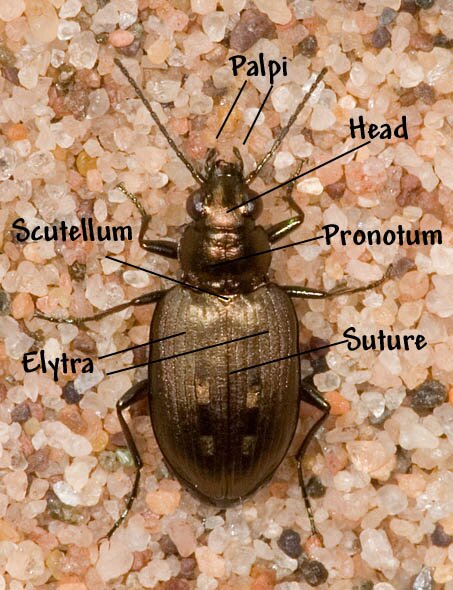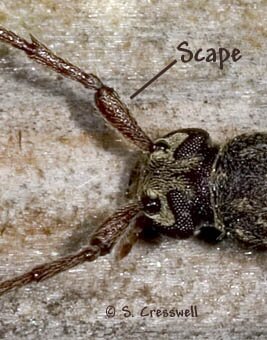 Elytral. Pertaining to the elytra.
Elytral. Pertaining to the elytra.Apex. The portion of a body part that is farthest of the central body or from the base. The apex of an antenna is the tip. The apex of the pronotum is the part nearest the head. The apex of the abdomen is the posterior (rearmost) portion. The plural of apex is apices. The opposite of apex is base.
Antennal types terminology page.
Antennomere. A segment of the antenna.
Apical. Pertaining to the apex.
Basal. Pertaining to the base.
Base.The portion of a body part that is closest to the central body and farthest from the apex. The base of the elytra is the part nearest the pronotum, and the base of the pronotum is the part nearest the elytra. The base of an antenna is the part nearest the head. The opposite of base is apex.
Congener. Said of a species that is in the same genus as the species at hand.
Costa. A modestly elevated ridge, as on an elytron.
Dorsal. The back, generally seen in a birds eye view of the insect.
Diurnal. Active during the day; the opposite of Diurnal is nocturnal.
Edges. The side margins of a structure, particularly the long sides of the elytra or pronotum.
Elytra. The front wings of a beetle, modified to serve as covers for the membranous rear wings. The elytra are often thickened and pigmented. The singular of elytra is elytron.
 Elytral. Pertaining to the elytra.
Elytral. Pertaining to the elytra.
Femur. The first elongate leg segment. Moving apically, the femur is attached to the tibia which is then attached to the tarsi. The plural of femur is femora.
Humeri. The front two corners of the elytra. This term is used particularly in species where the elytra are wider than the pronotum. The singular of humeri is humerus.
Instar. A period in the life of a larva, either between hatching and the first molt, or between two molts, or between a molt and pupation.
Labium. The lower lip.
Labrum. The upper lip, a structure that covers the base of the mandibles.
Longitudinal. Going in the "length" direction on the beetle as opposed to the "width" direction. For example, the elytral suture is longitudinal. The opposite of longitudinal is transverse.
Mandibles. The upper pair of jaws.
Margins. The edges.
Maxillae. The lower pair of jaws.
Oblique. At an angle; neither horizontal nor vertical; diagonal.
Palpus. A short, segmented structure; one pair is located on the maxillae and one pair on the labium. The plural of palpus is palpi.
Pronotum. The protective surface of the first segment of the thorax. Viewing the beetle dorsally, the pronotum lies between the head and the elytra.
Pubescent. Bearing soft, short hairs. See illustration below, at left.
 |
 |
|
|
|
Punctate. Bearing impressed dots. See illustration above, at right.
Pygidium. The final dorsal segment of the abdomen. In some species the pygidium is not covered by the elytra.
Rostrum. The beak or snout of a weevil. The plural is rostrums or rostra.
Scape. The basal segment of the antennae.

|

|
|
with its scape indicated. |
A Hide Beetle from New Mexico, showing where the base of the elytra meets the base of the pronotum; the line formed by this meeting is sinuate. |
Scutellum. The small, flat, usually triangular structure located between the elytra at their bases. The scutellum is occasionally semicircular or heart-shaped, and in some species the scutellum is hidden or lacking.
Setae. Bristles, stiffened hairs. The singular of setae is seta. See illustration at below left.
 |
 |
|
|
|
Shoulders. The front two corners of the elytra. This term is used particularly in species where the elytra are wider than the pronotum. Also called the humeri. See illustration at above right.
Sinuate. Said of a line or an edge that is wavy.
Striae. Impressed lines on the elytra, running in the same direction as the suture. The singular of striae is stria.
Striate. With striae present.
Striations. Same as striae.
Stridulation. A sound produced by rubbing one body part against another.
Suture. The place where the two elytra meet, forming an apparent line that runs the length of the elytra.
Tarsus. The apcial section of the leg, made up of two to five segments; the "foot." At its basal end the tarsus is attached to the tibia. The plural of tarsus is tarsi.
Tibia. The shin; the middle section of the leg located between the femur and the tarsus. At its basal end the tibia is attached to the femur; at its apical end the tibia is attached to the tarsus. The plural of tibia is tibiae.
Transverse. Going in the "width" direction on the beetle as opposed to the "length" direction. For example, the base of the pronotum runs in a transverse direction. The opposite of transverse is longitudinal.
Additional glossary page: Beetle Antenna Types
Note that on this glossary page, the beetles shown are not West Virginia species.